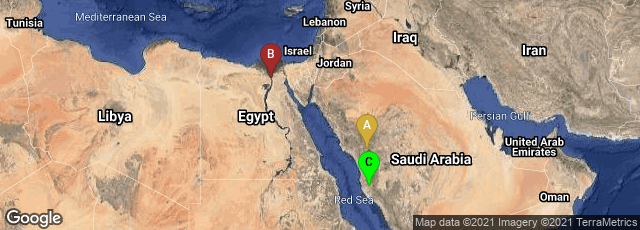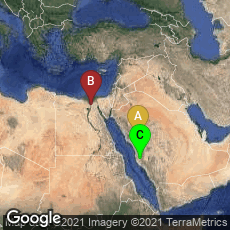

A: Al Suqya, Medina, Al Madinah Province, Saudi Arabia, B: Cairo Governorate, Egypt, C: مكة, الطندباوي, مكة المكرمة, Saudi Arabia
The recto of the first folio of codex Parisino-petropolitanus. The style is Hijazi script.
The codex Parisino-petropolitanus (BNF Arabe 328), one of the oldest surviving manuscripts of the Qur'an (Koran), was found among Qur'anic fragments which were kept in the 'Amr mosque in Fustat, Egypt, until the end of the 18th and the beginning of the 19th centuries when French scholar printer and founder in Alexandria of Napoleon's Imprimerie orientale Jean-Joseph Marcel, and Jean-Louis Asselin de Cherville, French consul in Cairo, bought a significant number of its leaves. Scholars have dated the manuscript as early as the late 7th century CE (third quarter of the 1st century AH). Others agree on a date in the early 8th century CE, and others suggest significantly later dates.
Surviving portions of the manuscript are preserved in the Bibliothèque nationale de France (formerly the Asselin de Cherville collection), the National Library of Russia in St. Petersburg (formerly the Marcel collection), the Vatican Library, and the Khalili Collection in London. The 98 surviving parchment folios measure 33 x 24 cm and contain roughly 45 percent of the Qur'anic text. From this data François Déroche inferred that the original manuscript comprised between 210 and 220 folios. The manuscript was produced by five scribes, probably working concurrently in order to meet demand for a fast production. All of the hands use the Hijazi (Hejazi) script, the collective name for a number of early Arabic scripts that developed in the Hejaz region of the Arabian peninsula, which includes the cities of Mecca and Medina.
"As with other hijāzī manuscripts, the Codex Parisino-petropolitanus is a codex, that is to say the dominant variety of book of the Late Antiquity. Its gatherings [of parchment leaves] are quaternions with the sides of the same kind facing each other—flesh facing flesh and hair facing hair. This not does mean that the gatherings were obtained by folding. Actually some 'accidents' interrupting the hair-flesh sides sequence (for instance f.42 to 48 of the Parisian part of hte manuscript) show that parchment bifolios equivalent to half a skin were stacked up one above the other and then folded. On the other hand the chines are located in places which exclude any folding process in the production of the quires" (Déroche, Qur'ans of the Umayyads. A First Overview (2014) 17-18 ff).
"The epistle of 'Abd al-Masīh ibn Īshāq al-Kindī claims that the early Muslims left the text of the Qur'an in the form of leaves and rolls like the scrolls of the Jews, until the caliph 'Uthmān changed this practice. See P. Casanova, Mohammed et la fin du monde: étude critique sur l'islam primitif, Paris, 1911, p. 121. . . ." (Déroche, op. cit. p. 18, footnote 6).
In February 2015 a digital facsimile of the most extensive portion of the manuscript, preserved in the BnF, was available at this link.